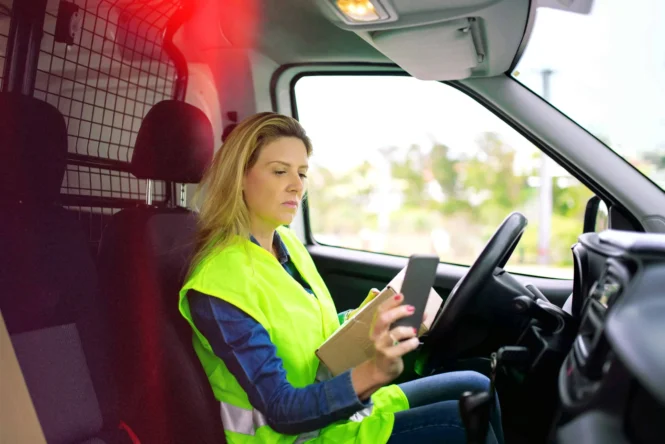Running a successful fleet operation means far more than just balancing the books between payroll and fuel bills. While those are significant line items, a surprising amount of loss happens in places most businesses don’t immediately measure—things like driver behavior, inefficient habits, delayed maintenance, and high turnover. That’s where modern driver monitoring systems can completely transform fleet management.
According to the team at Idrive, video telematics and behavioral monitoring tools do more than just record footage—they provide the critical insights needed to reduce five major categories of operational costs. And the truth is, the savings realized from this kind of data-driven management can quickly exceed the investment in technology itself.
Key Highlights:
- 📉 Collision costs drop with early detection of risky driving habits
- ⛽ Fuel and labor efficiency improve through behavior-based coaching
- 🛠️ Proactive maintenance prevents expensive vehicle downtime
- 📊 Telematics give better visibility into long-term cost patterns
- 👷 Improved feedback loops support retention and reduce driver turnover
- 🌱 Fleet culture shifts toward safety and accountability
Behavior Insights: A First Line of Defense Against Collisions

You already know that crashes cost money—but what you might not know is that over 50% of serious collisions are caused not by external conditions, but by human error. Distraction, slow reaction time, speeding, or reckless maneuvers often go unnoticed until it’s too late. Traditional tracking tools simply can’t capture these patterns.
That’s where video telematics comes into play. By using inward-facing and forward-facing cameras, fleet managers can spot risky behaviors before they become major liabilities. For example:
- Drifting between lanes might signal fatigue or distraction.
- Hard braking and tailgating often point to poor judgment or aggressiveness.
- Delayed reaction times can reveal a need for more rest or training.
The ability to identify and coach drivers before an accident happens is game-changing. Over time, this kind of targeted improvement translates into lower legal costs, reduced insurance premiums, fewer vehicle write-offs, and—most importantly—safer roads for everyone.
Fuel and Labor Optimization Through Smarter Coaching
Think fuel and payroll are fixed costs? Think again. A lot of waste hides in poor driving technique and inefficient time management.
Here’s how driver monitoring can expose it:
- Jackrabbit starts (sudden accelerations) burn through fuel and wear down engines.
- Long idling periods drain gas without adding any value.
- Unnecessary speeding increases the chance of tickets, with little to no time saved.
- Inefficient routing leads to extra miles, extra hours, and higher labor costs.
By analyzing driver behavior through telematics, managers can identify and address these inefficiencies early. With data-backed coaching, drivers can shift their habits—reducing idle time, using smoother acceleration, and making smarter routing decisions.
And with fuel prices as unpredictable as they are, even small improvements in efficiency can lead to massive year-end savings.
Maintenance Matters: Preventing Breakdowns Before They Happen
Maintenance is a silent budget killer—especially when it’s reactive rather than proactive. Most fleets deal with vehicle issues only after a breakdown has occurred. That means unplanned towing, emergency shop repairs, and potentially days of lost productivity.
But telematics systems offer a different approach. Sensors can track:
- Brake wear
- Engine temperature spikes
- Oil pressure anomalies
- Coolant leaks
- Battery health
When these early warning signs are detected, the vehicle can be brought in for servicing during routine maintenance windows—before a full-blown failure happens. This not only keeps the fleet running smoothly, but it extends vehicle lifespan and dramatically cuts replacement costs.
Turning Raw Data into Actionable Expense Forecasts
Let’s say you’ve got driver cameras and engine sensors installed. That’s great—but what do you do with all that data?
This is where contextual analytics make a real difference. When fleet managers connect dots between different behaviors—such as acceleration intensity, braking frequency, and idling time—they can start projecting true driver efficiency in measurable terms.
This isn’t just about punishing poor performers. It’s about creating realistic benchmarks and improvement plans. You’ll be able to:
- Identify drivers with the highest fuel waste
- Spot those who may need retraining or coaching
- Reward consistently safe and efficient performers
Over time, this visibility allows you to shift from reactionary operations to predictive planning, reducing uncertainty in your fleet’s financial outlook.
The Culture Shift: Using Tech to Retain Your Best Drivers

Let’s talk about something most fleet managers overlook: driver turnover.
Losing drivers not only impacts continuity, but it’s also a hidden expense. Hiring, onboarding, and retraining new staff is costly—and while they ramp up, your business suffers delays, miscommunication, and potential service issues.
Here’s where driver monitoring makes a surprising difference.
While it’s easy to assume constant surveillance might feel invasive, the opposite can be true—when implemented with the right approach. Instead of using video data to punish, many companies now use it to reward and retain:
- Positive reinforcement for consistently safe driving
- Recognition programs based on real behavior data
- Constructive feedback loops that make drivers feel heard, not hunted
Studies show that positive coaching is more effective than fear-based tactics. It creates a culture of mutual respect, safety, and growth—and people stay where they feel valued.
Driver Monitoring and Insurance Savings
One of the most immediate and measurable benefits of video telematics is its impact on insurance premiums. Fleets with behavior monitoring and driver coaching in place are statistically lower risk. Many insurers now offer discounted premiums or special programs for fleets that integrate this technology.
What’s more, in the event of a crash, video footage can help protect the business from false claims. This can prevent long and expensive legal battles that drain resources and damage reputations.
For example, having video evidence of a driver maintaining safe following distance or obeying speed limits can exonerate your company in disputes—something a standard GPS log simply can’t provide.
Scaling Driver Insights Across Multi-State Fleets
For national or multi-regional fleets, consistency is everything. Monitoring tools provide a centralized way to enforce standards across diverse locations and drivers. When every branch sees the same performance metrics and safety benchmarks, training becomes unified—and scalable.
You can compare routes, understand geographic influences on driving patterns, and even tailor coaching based on urban versus rural risk factors. It’s not about micromanaging; it’s about managing smartly at scale.
How to Choose the Right Driver Monitoring System
Not all telematics systems are created equal. If you’re looking to adopt a driver behavior analytics solution, here’s what you should look for:
- Dual-camera systems (forward + inward)
- Real-time alerts and cloud-based access
- Integration with your dispatch and maintenance software
- Customizable dashboards for driver performance reviews
- GDPR or data compliance capabilities
The best systems give you the right balance of data, automation, and human interpretation. Make sure the vendor offers training and support, too—technology is only as useful as your team’s ability to apply it.
Use Data to Empower, Not Punish

Driver monitoring isn’t about replacing people with machines—it’s about giving your team the tools they need to succeed. From reducing collisions and fuel waste to preventing breakdowns and building a positive team culture, video telematics brings unmatched value to modern fleet operations.
Small insights—like a second of distracted driving or a 15-minute idle—might not seem like much. But multiply that across 100 drivers over 12 months, and suddenly you’re looking at six-figure cost differences.
If you’re serious about optimizing fleet performance and cutting hidden expenses, the solution isn’t just more oversight—it’s smarter oversight.
 Imagup General Magazine 2025
Imagup General Magazine 2025



